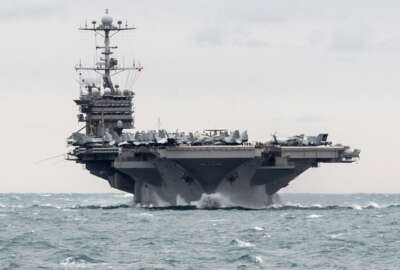
Navy finds Congress friendlier as service continues to go green
The Navy's top energy official said he thinks the tide is turning in Congress when it comes to green energy and the military.
Congress is coming around to the military’s green initiatives as the Defense Department continues to prepare for a world scarce of fossil fuels.
“It is changing up on the Hill. I use as evidence the interaction at [Navy] Secretary [Ray] Mabus’ posture hearings before the Senate Armed Services Committee as well as the House Armed Services Committee about six weeks ago. It just wasn’t the heated issue about energy,” said Assistant Navy Secretary for Energy, Installations and Environment Dennis McGinn during an April 12 speech.
McGinn’s comments come just months after the Navy deployed its Great Green Fleet, an initiative where ships, aircraft, amphibious and expeditionary forces will use energy efficient systems, procedures and alternative fuel for their missions.
The fuel blend works just as well as regular petroleum and costs DoD $2.05 a gallon. The Agriculture Department chipped in 14 cents per gallon to support “the American farmers in the Midwest who supplied the waste beef fats,” Mabus said during the fleet’s send off in January.
The Navy has set goals of reaching 50 percent total energy consumption from alternate sources by 2050 and producing at least 50 percent of shore-based energy requirements from alternative sources by 2020.
Despite a recent drop in oil prices, McGinn said the Navy remains dedicated to biofuels.
“Some would say ‘Well wait a second, why are you pursuing biofuels when we have a seeming abundance of petroleum around in the world. The prices are down below $40 a barrel, sometimes below $30 a barrel. Why are you spending any time and any resources to develop biofuels?’” McGinn said.
He said the answer is obvious. The Navy does not gauge its decisions based on the next quarterly or annual report. The Navy thinks beyond to 10 or 15 years down the road.
“What we see in that down the road, over the horizon environment is a lot of competition for regular petroleum based fuel and the next 25 to 30 years and increase in the world’s population from over 7 billion today to 9 billion by 2050 and increasing prices for all energy sources,” McGinn said. “It makes sense if we can diversify our portfolio.”
The Navy is now looking into other ways green technologies can help in other areas. One place the Navy is looking is microgrids, small electricity distribution systems.
The Navy wants to pair them with storage capability and put in power monitoring and control systems. That will allow the service to change the load that is using the power, the sources of the power and to blend them in an optimal way.
McGinn appealed to industry to continue its work in energy efficiency.
“If build it we will come. If you build a biorefinery we have a demand for biofuel to put in our ships and our aircraft in our Navy and Marine Corps. If you build a solar field or geothermal capability or wind capability we want to access that where it makes sense and where there’s a business case,” McGinn said.
Part of McGinn’s perception of a tide turning in Congress may be due to the successes the Navy has had in going green.
“We were given a goal in May 2014 that by the end of 2015 that Sec. Mabus wanted us to have, over various stages of procurement, over 1 gigawatt of renewable energy,” McGinn said at an Atlantic Council event in Washington. “Well, we achieved that, we got up to 1.1 gigawatts and we are considering that a floor not a ceiling and we did that almost exclusively with private public partnerships.”
Not everyone is convinced though. Brian Slattery, a policy analyst at Heritage Foundation, said DoD’s strategy should be guided by what is making it the most capable military to defense U.S. interests.
Slattery said he is concerned green policies could cloud DoD’s judgment.
“It’s kind of like putting climate change on top of the things the Department of Defense is already doing. If anything, it will just be further emphasis on considerations that … planners in the military are already taking into consideration,” Slattery said.
McGinn said it’s not that DoD is a “closet tree hugger,” but rather that the business case for going green is so strong.
The Navy is doing this “because we are in the business of fielding the most expeditionary capable Navy and Marine Corps team that we can,” McGinn said.
Copyright © 2025 Federal News Network. All rights reserved. This website is not intended for users located within the European Economic Area.
Scott Maucione is a defense reporter for Federal News Network and reports on human capital, workforce and the Defense Department at-large.
Follow @smaucioneWFED





